The Best Leg Workout for Running Faster & Longer
Strength training is an important aspect for all marathon runners. Follow these leg workouts for running to get you marathon-ready to run longer, faster.
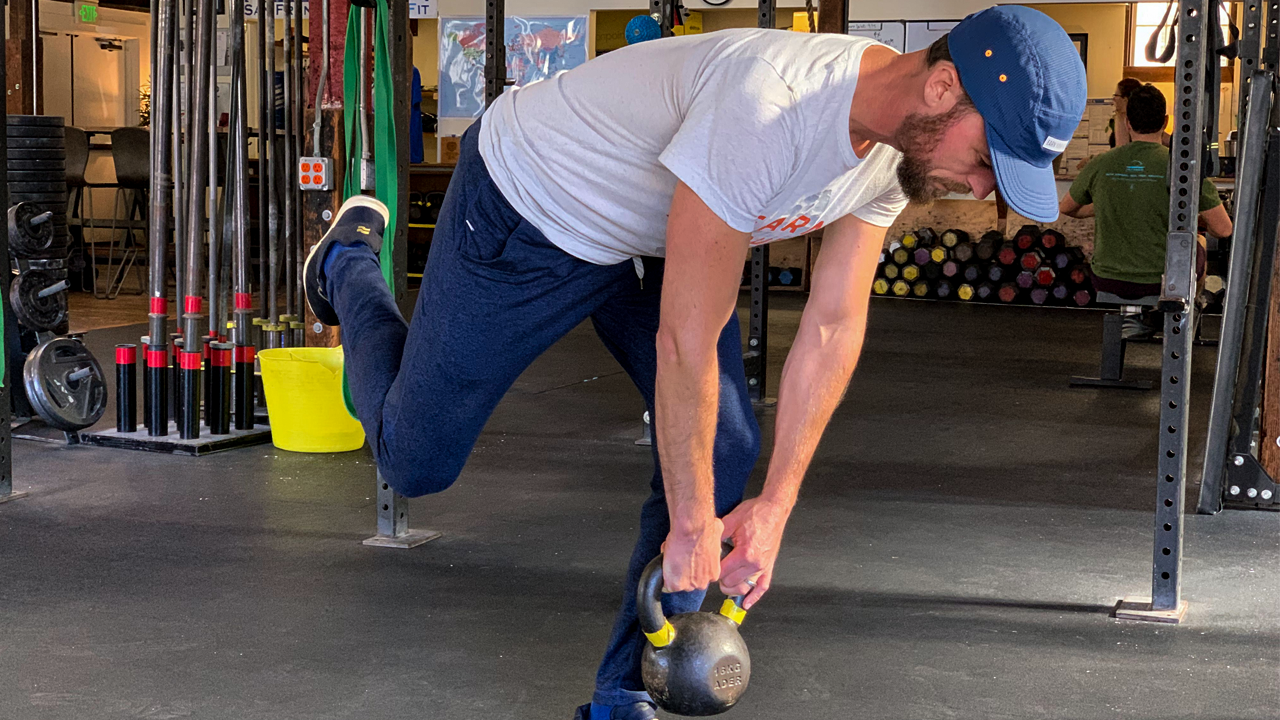
It’s one thing to be strong on two legs, but another to be strong on one, especially for marathon runners. But, how do you get it? We’re here to help! Read on for some leg workouts for running that’ll help you race longer and faster by improving your running form.
Ultimate Leg Workout for Running Longer and Faster
When it comes to elevating your marathon game, strength is key – but not just any strength. What really makes a difference is targeted leg strength, particularly the kind that enhances each stride, reduces injury risk, and propels you further, faster. That's why we're excited to share our ultimate leg workout, designed specifically for runners who are eager to improve their endurance and speed.
Running isn't just a two-legged race—it's a rhythmic alternation of single-leg stances. Each time your foot hits the ground, your entire body relies on the strength and stability of that one leg. This workout zeroes in on building power where it matters most, transforming your legs into a more resilient and efficient duo. We focus on exercises that not only strengthen the muscles but also improve your running form, balance, and coordination.
Whether you're a seasoned marathoner or a newbie with ambitious goals, these exercises are your secret weapon. They're crafted to address the unique demands of long-distance running, ensuring each step you take brings you closer to your personal best. Get ready to discover how these carefully selected leg workouts can revolutionize your running performance, helping you to glide over miles with newfound strength and ease.
Single-Leg Strength: Why Do You Need It?
In the world of marathon running, single-leg strength is more than just a beneficial attribute; it's a cornerstone of efficient and injury-free running. Here's why focusing on single-leg strength should be an integral part of your training regimen:
Running, at its core, is a series of single-leg balances. Each stride you take is a moment where one leg bears the full load of your body. Strengthening each leg individually mirrors these dynamics, providing a direct benefit to your running efficiency.
Single-leg exercises challenge and improve your balance and coordination. These are vital skills for navigating uneven terrain and maintaining form, especially during the later stages of a marathon when fatigue sets in.
Injury Prevention and Recovery
Most people have one leg that's naturally stronger or more stable than the other. Single-leg training helps to even out these disparities, reducing the risk of overuse injuries that often stem from imbalances.
If you’re recovering from an injury, single-leg exercises allow you to focus on strengthening the affected leg without overburdening the healthy one. This targeted approach promotes quicker and more effective recovery.
Performance and Endurance
With stronger individual legs, each stride requires less effort. This increase in efficiency can lead to noticeable improvements in both your pace and endurance.
Single-leg strength training enhances your explosive power, crucial for tackling hills and sprints. This translates into faster, more powerful running, especially in the critical moments of a race.
Best Leg Exercise for Runners: The Single-Leg Squat
The single-leg squat. We can’t lie to you…this isn’t going to be an easy one. But it’s going to WORK. FAST.

- Start by standing tall on two feet. And then on one.
- From here you’re simply going to sit your hips back (like you do in a regular squat) and bend your standing leg, pushing the knee out.
- Your “end” position will be the leg that’s off the ground landing in a lunge behind you with both your knee and toe on the ground.
Make sure you continue sitting your hips back to create a hinge and space for the upper body to lean forward, over your standing thigh.
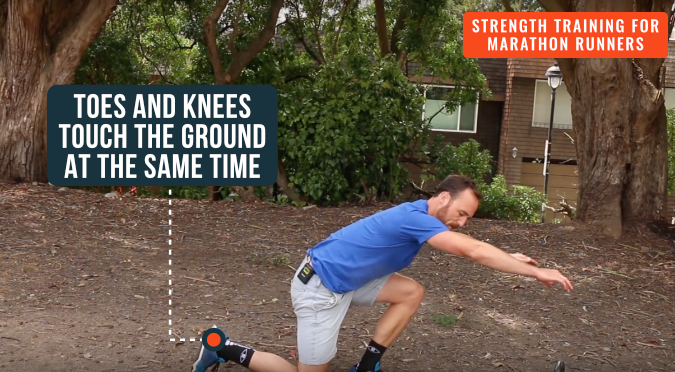
From the bottom of the lunge, you’ll press out of your standing glute and heel to return to standing on two legs.
But here’s where it gets a little complicated. That first lunge took you what, one second? From here, we’re going to slow down the process of getting to the lunge to almost four seconds.
You can slow the speed gradually, as you gain control over your standing leg.
Leaning forward with the upper body as you sit the hips further back will help counterbalance your weight, allowing you to move slow. Make sure your knee and toe come to the ground at the same time but DO NOT allow your kneecap to slam into the ground, for any reason.
Here’s the sequence:
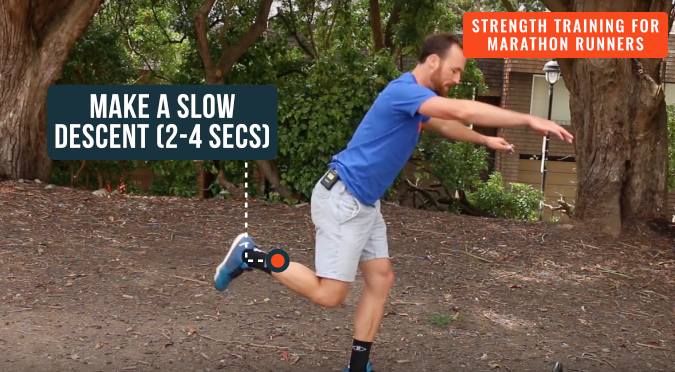
- Do three sets of five repetitions per leg, each taking between three and four seconds.
- Rest one minute between sets.
From here, you can build this leg workout for runners up to five sets of five repetitions per leg.
This type of strength training for marathon runners helps fight the “hip sink” that occurs as you get tired.
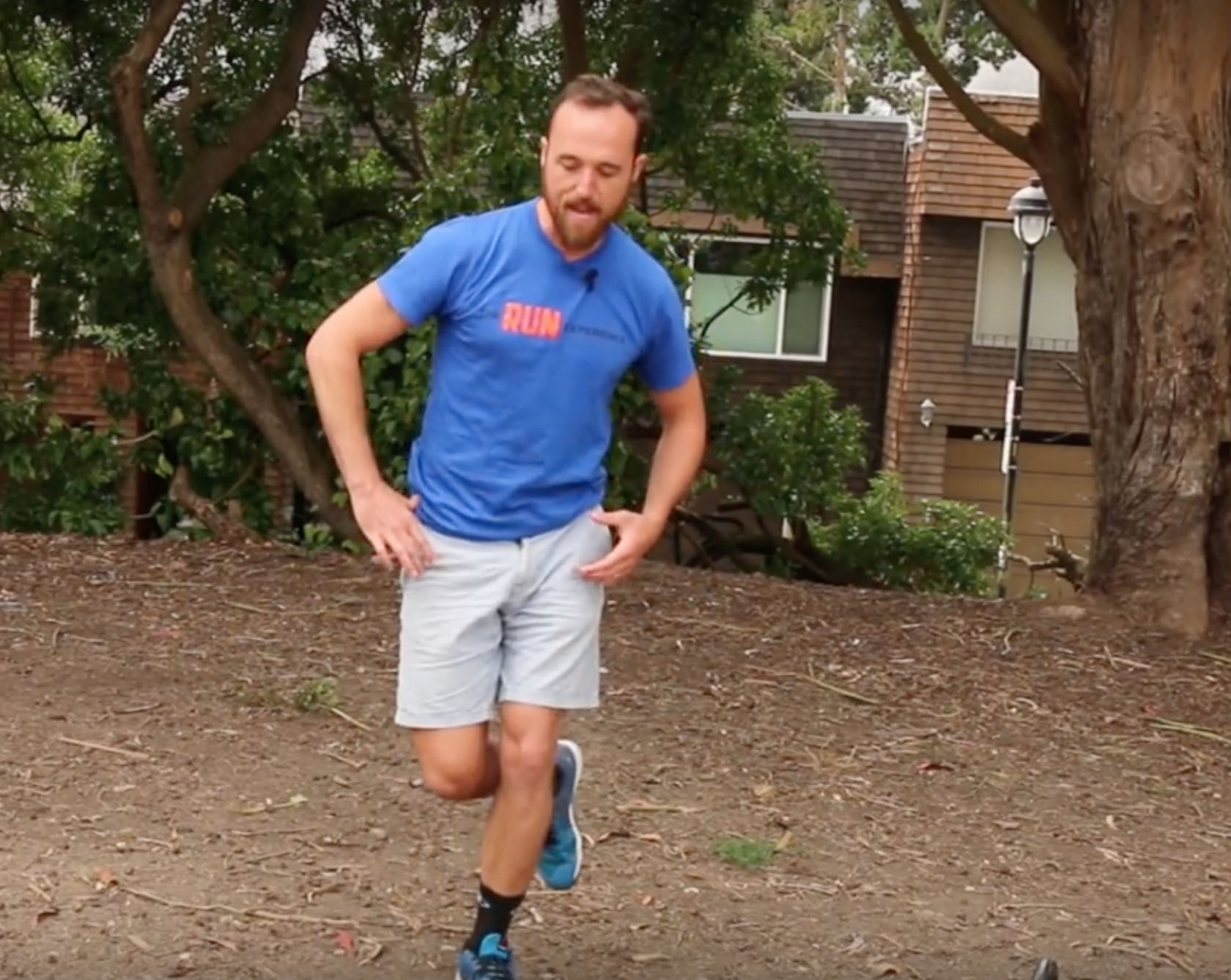
The Ultimate One-Leg Exercise for Marathon Runners: The Runner’s Deadlift
We’ve all “deadlifted” something at least once in our lives…a barbell, a kettlebell, a sock we dropped on the floor. But today we’re going to look at what it means to deadlift using just one leg. Welcome to the deadlift for runners.
Let’s start this leg workout for runners by practicing a few regular deadlifts, using a kettlebell (18-35 lbs is just fine) or something of similar weight (milk jug will do the trick).
- Standing on two feet, sit the hips back, letting the knees find a sustained bend, with the upper body again pitching forward from the hips. Do NOT let the back curve or “round” over!
- From here, you’ll squeeze your glutes and pick up your kettlebell.
- Now, repeat exactly that while holding your kettlebell.
- Keep your arms straight, shoulders squared, and kettlebell right between your shins as you straighten and bend your legs.
Now, let’s try it on one leg.
Again, what we’re trying to do here is practice stabilizing the hips and ankles for each leg of our run stride.
- Let’s start without the kettlebell. Stand on one leg, taking a few seconds to find your balance.
- From here, you’ll sit the hips back just like before, taking a slight bend in the knee and pitching the body forward, keeping the back straight.
- The leg in the air will be bent at a 90 degree angle behind you–make sure you’re flexing your heel to the sky.
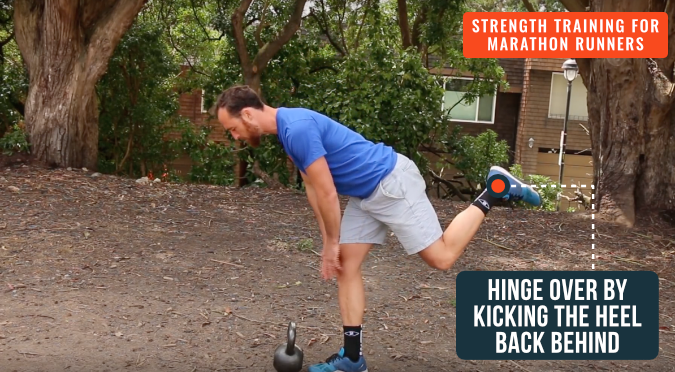
- For now, only deadlift until your hands are resting on your knee or just below it. No need to bend further.
- Return to standing. Now grab the kettlebell, holding it with two hands.
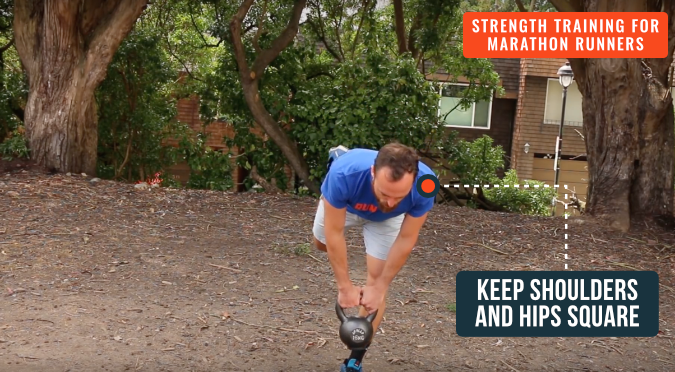
Make sure to find your balance on one leg with the weight, before starting the deadlift.
Perform the deadlift in the exact same way you did before, only this time making certain that the kettlebell is traveling right against your standing leg, and only reaching to right below the knee before standing back up.
Remember, keep your shoulders square to the ground!
Leg Workout Variations
Here are a few variations you can try to make this more challenging:
- Hold the kettlebell with just ONE hand (the one opposite of the leg you are standing on)
- Increase the bend on your standing leg so that kettlebell taps the ground on each rep
Once you’ve found a version that works for you, here’s your rep scheme:
- Three sets of five repetitions, per leg.
- Increase to 5+ sets of five repetitions.
- You can take a one minute rest between sets.
Start Your Leg Workout Routine for Runners
Sinking into your hips creates unnecessary pressure on the ankles, knees & hips. After enough repetition with poor form, those injuries are no doubt going to creep up on you.
These best leg exercises for runners will teach your hips and ankles to stay stable and square through all of the weight transfer that occurs when you run.
So practice these movements 1-2 times per week for best results!
For sticking with us to the end, enjoy 2 full weeks of strength workouts just like this one. Each leg workout for running includes video coaching, a written description, as well as access to our coaches for any modifications or questions that come up along the way! Get your FREE program here.
Ready to get started? Don’t forget to download our new mobile app for access to coaching advice, daily video workouts, injury prevention tips, and complete training programs that will help motivate and inspire your marathon training program!
